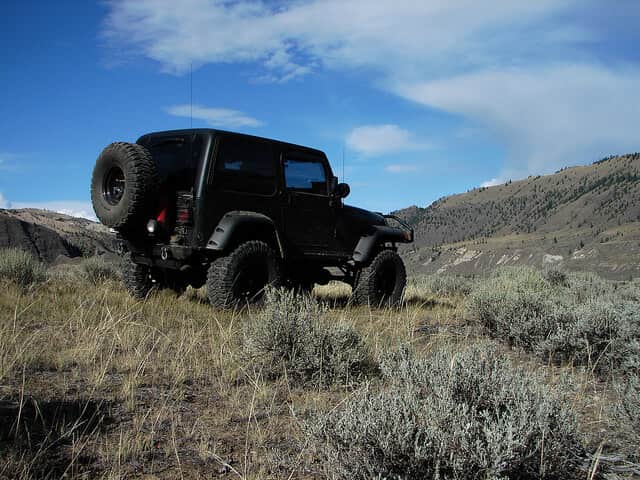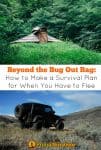It is crucial that you have a plan for bugging out (or evacuating, or whatever you want to call it). This guide is meant to help you formulate your bug out plans so you can be safe regardless of what disaster strikes.
1. Figure Out What Bugging Out Means to You
Bugging out means something different to everyone; every strategy will be unique to your circumstances.
This should be obvious.
Yet, most prepping websites tend to glamorize bugging out. They make it seem like a camping trip with your buddies. If they are so eager to bug out into the wilderness, they should buy a cabin in the woods somewhere and start homesteading.
You don’t have to wait for a SHTF disaster to start living the life you want!
But we are talking about survival in disaster situations, so you must understand what bugging out means for you or your group.
Here are just some of the base considerations:
- Under what conditions will you flee? Read this post on bugging in vs. bugging out.
- What are your strengths/weaknesses?
- What disasters are most likely to occur in your area?
- Is your area urban, suburban, or rural?
- Will your community be an asset or a danger?
2. Have Bug Out Essentials Ready to Go

Most preppers tend to focus on this when talking about bugging out. So, I don’t want to dwell on it too long. Check these bug out lists to see what essentials you need:
- Bug Out Bag Packing List
- Emergency Binder List (emergency documents)
- Best Bug Out Bag Food
- Bug Out Bag First Aid Kit List
- How to Build a Bug Out Bag for Your Family
But having a bunch of gear is useless if you can’t access it. For example, what if disaster strikes while you are at work, but your BOB is at home?
Or what if someone steals your Bug Out Bag?
Thus, your bug out plans better include tactics like:
- Making multiple Bug Out Bags
- Keep BOBs at home, work, school, in your vehicle, and anywhere you go frequently
- Camouflaging your Bug Out Bag
- Making a survival cache
3. Disaster Communication Plan
This is one of the essential elements of disaster preparedness, yet it is also one of the most overlooked parts of planning.
Let’s say that a disaster strikes while your kids are at school. Because cell phones rarely work during major disasters, how would you get in contact with your kids?
Do you know what the school’s policy is for disasters?
All experts agree that the most crucial part of successfully bugging out is to get out of the disaster zone early. Getting out early means avoiding the crowds, rioting, martial law, and road closures…
So make a disaster communication plan with a specific rally point and meetup instructions so you and your loved ones can get out of dodge ASAP.
For more on this, read How to Make an Emergency Communication Plan.
4. A Specific Bug Out Location

Many people buy property in remote areas to go to in a major disaster. If you can afford it, then this is worth considering. Even if a disaster never occurs, you can still use the bug out location for weekend getaways.
Let’s be honest: Picking a good bug out location is tough!
You’ve got to consider the following:
- Safety
- Accessibility: Ideally, your BOL is no more than 1 tank of gas away
- Isolation
- Access to water
- Shelter
- Protection/defense options
- Whether it is suitable for long-term survival
Read The 8 Requirements of a Good Bug Out Location for more.
What if you can’t afford a Bug Out Location?
Think creatively; campgrounds, national parks, and abandoned factories could be options. I’m sure you can think of plenty more in your local area.
None of these are ideal solutions (think of all the strung-out junkies who might be lurking in an abandoned factory!)
However, having a specific location in mind – even if it isn’t perfect – is better than not having a place to flee to at all.
*Once you’ve found a bug out location, remember to stock it with survival supplies – even if it means burying a survival cache in the ground.
5. Choosing Your Route
Remember the days when people used paper maps instead of GPS? As the BBC talks about here, there are many reasons — from solar storms to cyberattacks — that our GPS systems could stop working.
So, while GPS systems are fantastic, don’t rely solely on them.
You’ll want a detailed paper map of the area to plan your bug out route. You’ll want to be looking at things like:
- What backroads will take you to the BOL?
- What alternative routes are there?
- What is the terrain like?
- Are there any good drop points along the way?
- How will seasonal conditions (flooding, snow, etc.) affect the route?
6. Bug Out Vehicle

This is another area discussed (more like argued about) in the prepper community. Some feel that a big, rugged off-road vehicle is the only way to go.
Others insist that modern vehicles will be useless because of EMP.
Most of these arguments fail to point out that dozens of types of disasters could occur, and the “best” bug out vehicle will differ for each.
Here are just some options:
- Off-Road Vehicle
- Motorhome
- ATV
- Car
- Motorcycle
- Bicycle
- Foot
- Boat
Read our article about bug-out vehicles here.
You Must Have a Backup Bug Out Vehicle
The core idea behind disaster prepping is that you always hope for the best but plan for the worst. Thus, you must expect bug out vehicle failures such as:
- Your bug out vehicle breaks down
- It gets stolen
- Roads are closed
With these failures in mind, always have a Plan B vehicle and factor it into your plan!
7. Drills
You need to run a drill of your bug out plan so you can:
- Make sure that everyone in your group knows what to do
- Be more mentally prepared for a real-life event
- Determine how long it will take you to get to safety
- Catch any holes in your plan
This last point is crucial. It isn’t until you do a drill that you realize problems with your plan, such as your BOB being too heavy, it will take you much longer to get to your location than you thought, or your gear malfunctioning.
8. Adjust Plan As Necessary
Hopefully, you will keep doing drills of your bugging out plan, testing them in different seasons and conditions.
Don’t be surprised if you end up tweaking your bug out plan after each drill. There is no “right” way to make a disaster plan. You can only strive to do your best to prepare for the unknown.
Are you making a bug out plan? What other steps do you think are essential for survival?




Thank You.